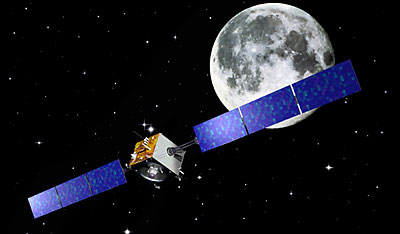Lunar science missions: the smallsat alternative<< page 1: the smallsat alternative International cooperation and competitionSmallsats also lend themselves nicely to international cooperation. Much of the smallsat development expertise is located outside the US: one of the premier smallsat companies, Surrey Satellite Technology Ltd., is located in the UK, while there are many other smallsat efforts elsewhere in the world. Given that international cooperation is one of the goals of the exploration initiative, smallsats offer a relatively low-cost, low-risk first step that could lead to bigger roles for international participants in the future. International cooperation also opens up new launch options: working with European and Russian partners could allow smallsats to launch on low-cost Russian vehicles like Dnepr and Rockot. NASA has already taken advantage of this: in 2002 the twin Gravity Recovery and Climate Experiment (GRACE) spacecraft, a joint effort of NASA and the German space agency DLR, launched on a Rockot. International cooperation allowed NASA to use the Russian vehicle for most likely a small fraction of the cost of an American vehicle.
Hand in hand with international cooperation is international competition. At the same time the US is planning LRO, a number of other nations are also planning their own, albeit less ambitious, lunar missions. By the late 2008 launch date of LRO several other countries will have sent spacecraft to the Moon, including Europe (SMART-1), Japan (Lunar-A and Selene), China (the first Chang’e mission), and India (Chandrayaan-1). Some members of Congress have raised concerns that the US is somehow falling behind in a new race to the Moon. While such concerns are most likely unfounded, NASA could mitigate them nonetheless with a fast-track smallsat program that would send the first mission to the Moon one to two years earlier than LRO. Indeed, there is a way that NASA could jumpstart this smallsat lunar exploration even faster, while at the same time promoting commercial space development. TransOrbital is developing TrailBlazer, a small lunar mission designed to return high-resolution images and video of the lunar surface. That spacecraft is under development and is scheduled to launch in late 2004, although that launch date has slipped several times and could slip again. NASA could partner with TransOrbital to either purchase some of the data from the mission and/or fly additional instruments on the spacecraft, for the fraction of the cost of a dedicated smallsat mission, let alone LRO. This could give NASA some of the data it plans to acquire with LRO well in advance of current plans, not to mention ahead of other nations’ missions. For TransOrbital, a deal with NASA would give the company an additional revenue stream; a down payment from NASA could also provide the company capital to help finish and launch the spacecraft. Is smaller better?Some will no doubt argue that a smallsat approach like this is not radical enough: instead, NASA should go to a more purely commercial approach, and rely on mechanisms like data purchases and prizes to obtain the information they need. (See “Commercializing the new space initiative”, March 1, 2004) Indeed, NASA has a prize program, Centennial Challenges, in the works that could eventually include prizes for “micromissions” to the Moon and elsewhere. However, one can argue that the commercial market may not be mature enough yet to support such mechanisms, which require up-front private investment of tens of millions of dollars for an uncertain payoff, not to mention as-yet unqualified commercial markets for such missions. A NASA-supported lunar smallsat program would seem to strike a middle ground between entirely commercial lunar missions and large government efforts like LRO.
If smallsats are so attractive, why is NASA pressing ahead with LRO? NASA has claimed that because of the relatively near-term deadline imposed by the President’s plan to begin lunar exploration, they have little choice than to proceed with the internal development of a large lunar spacecraft. Yet, as this essay has noted, smallsats could be providing data to NASA scientists long before LRO’s planned launch date. Keep in mind that the President’s plan didn’t specify what or how much data would have to be returned by 2008, only that lunar exploration would begin by that year. Moreover, given the propensity of large space projects to suffer schedule slips, it’s quite possible that LRO, if it continues as planned, won’t fly before 2009—or later. What might be motivating LRO more is the available suite of launch vehicles, and their costs. A smallsat program suddenly looks less inviting if one is limited to current launch vehicles like the Taurus, which costs NASA about $50 million a flight. By comparison, the much larger Delta 2 costs $80-90 million. Even an EELV-class vehicle, which costs NASA as much as $140 million, would be cheaper than three Taurus launches of smallsats. Only if one assumes that cheaper foreign or domestic launch options will be available do smallsats look attractive. For NASA, it might simply be less risky to assume that those options won’t materialize. Ultimately, the problem may be with thinking big when smaller will do. In testimony before the Senate Commerce Committee’s space subcommittee last month, Sven Grahn, vice president of the Swedish Space Corporation, described the development of SMART-1 by his company, a relatively small player in the space industry. When pressed by subcommittee chairman Sen. Sam Brownback to explain the rationale for doing a small mission when NASA was pursuing a larger one, Grahn offered a simple explanation. “Big organizations want to do big programs,” he said. “Smaller organizations can get along with smaller programs.” Perhaps it is time for NASA to recognize that while it is a big organization capable of doing big programs, not every program it does needs to be big. Home |
|
